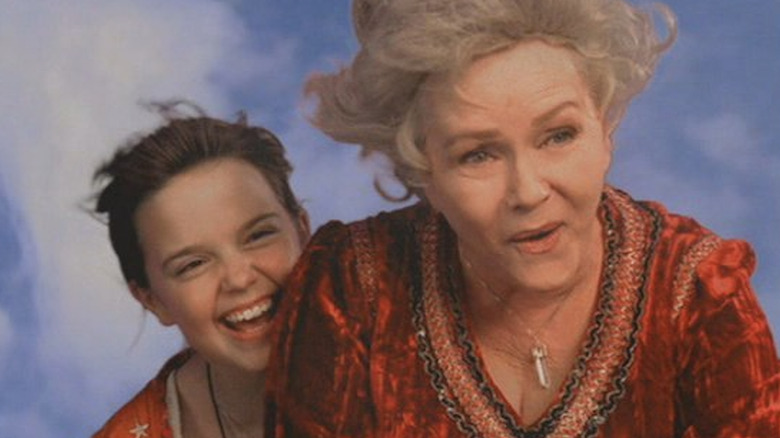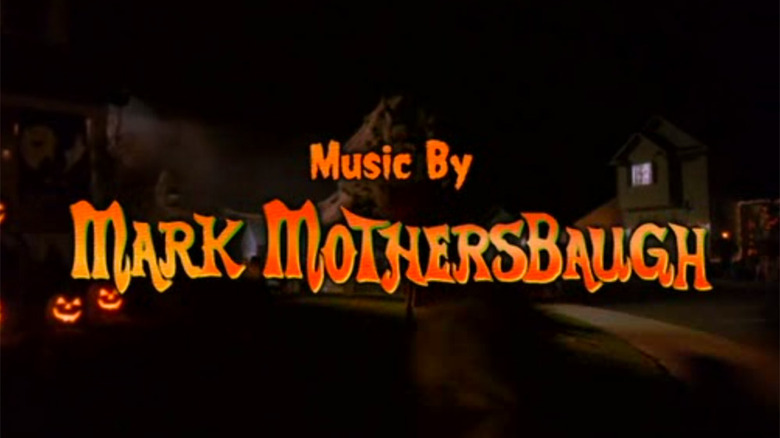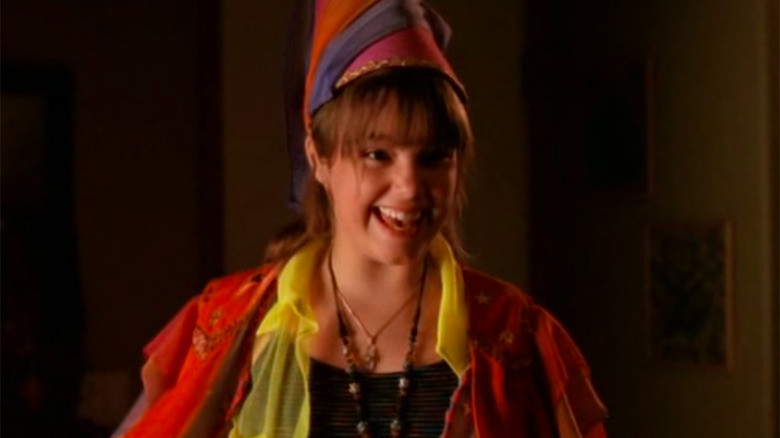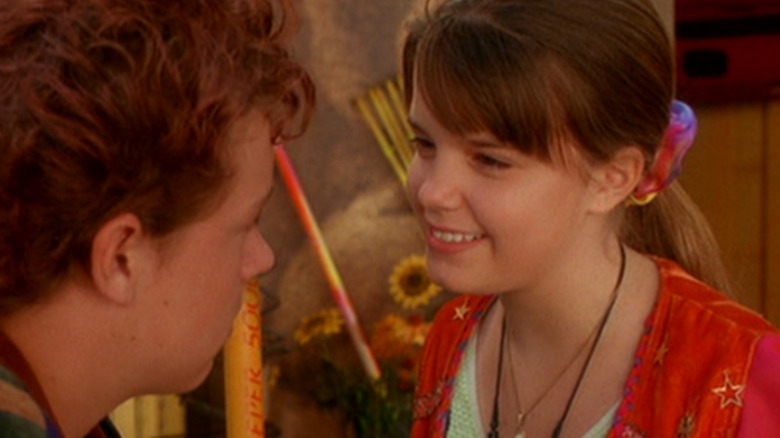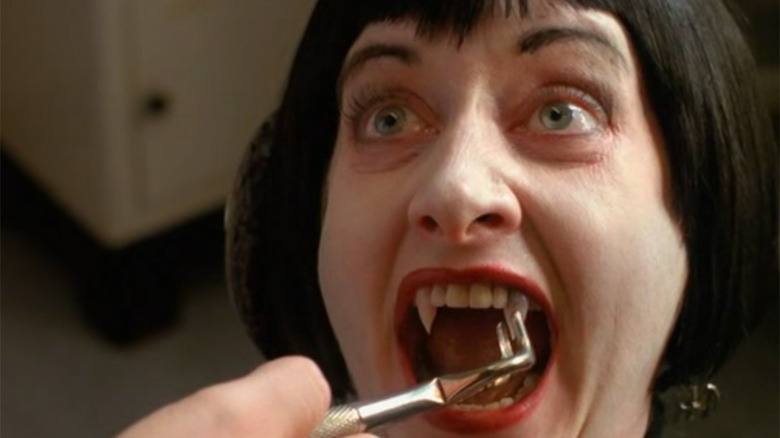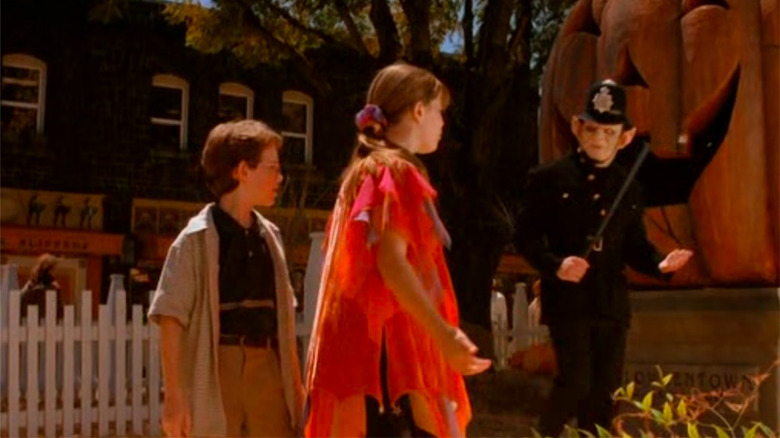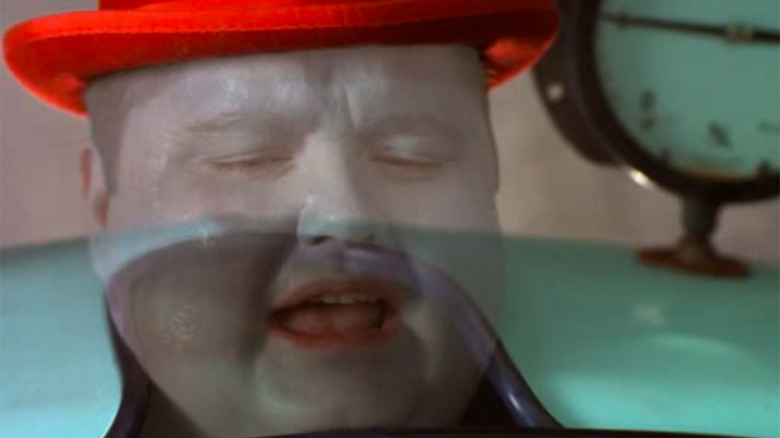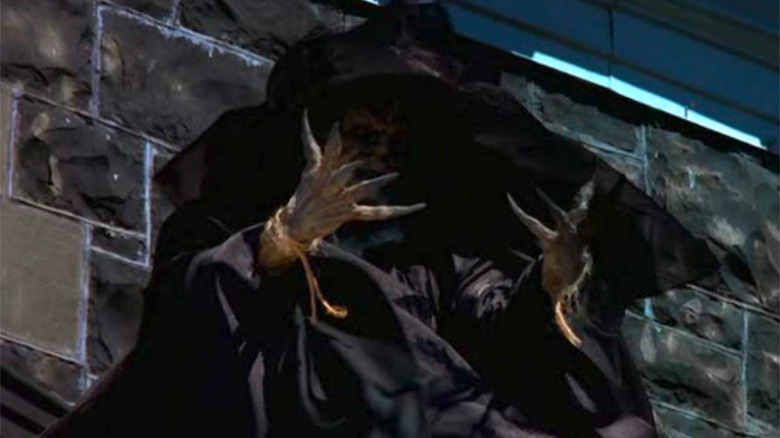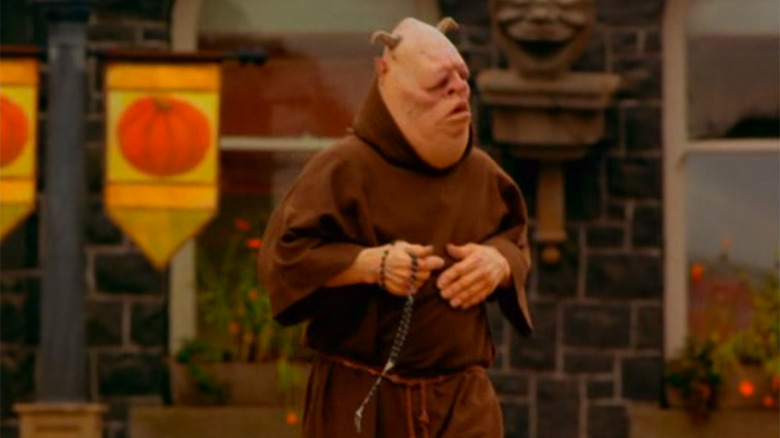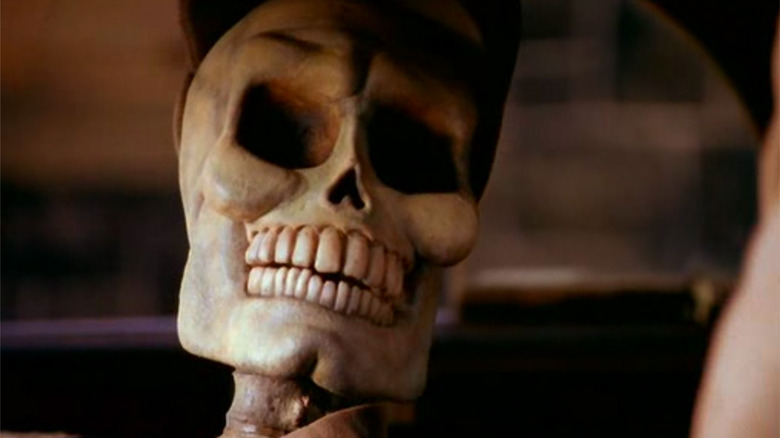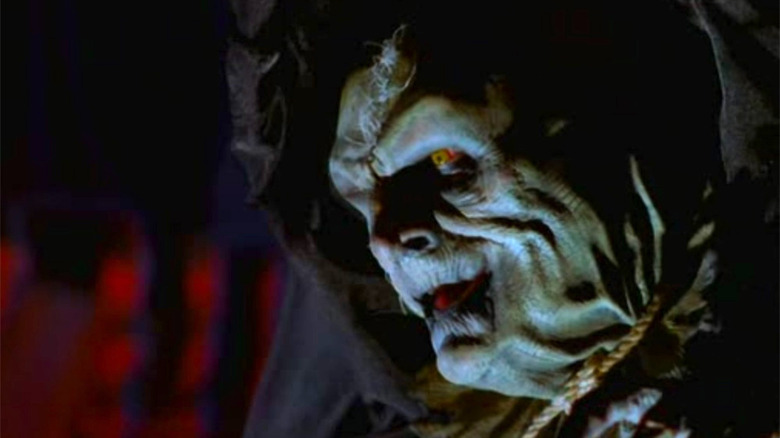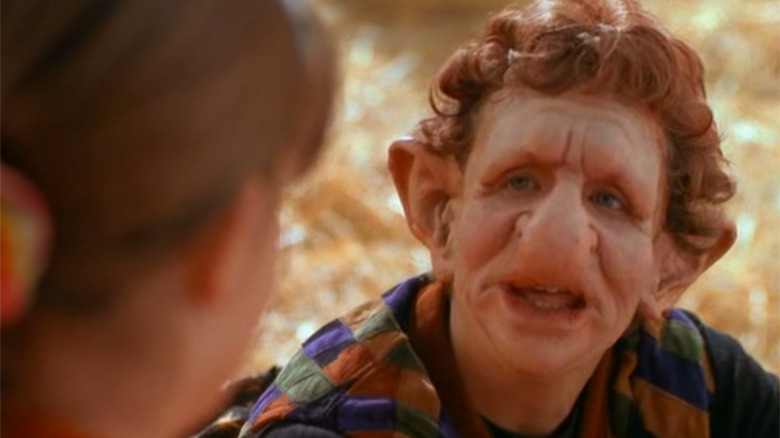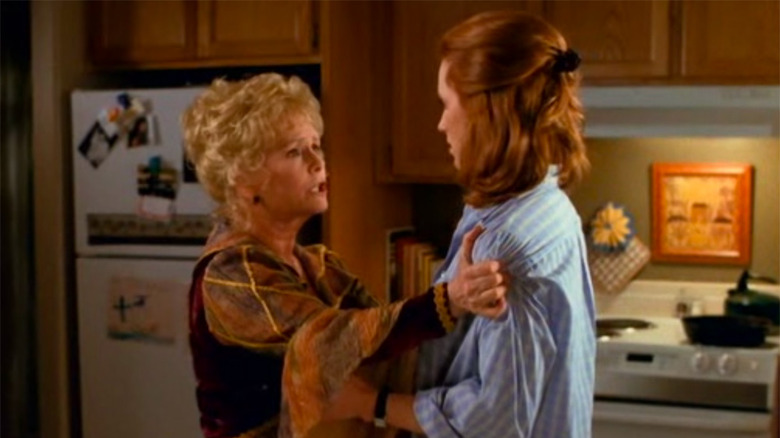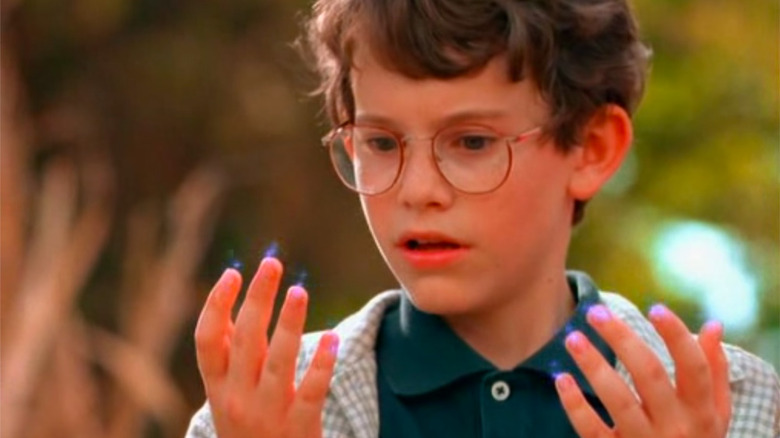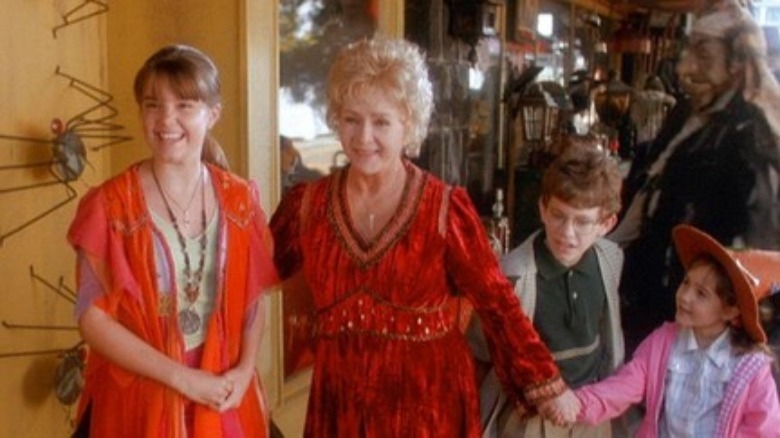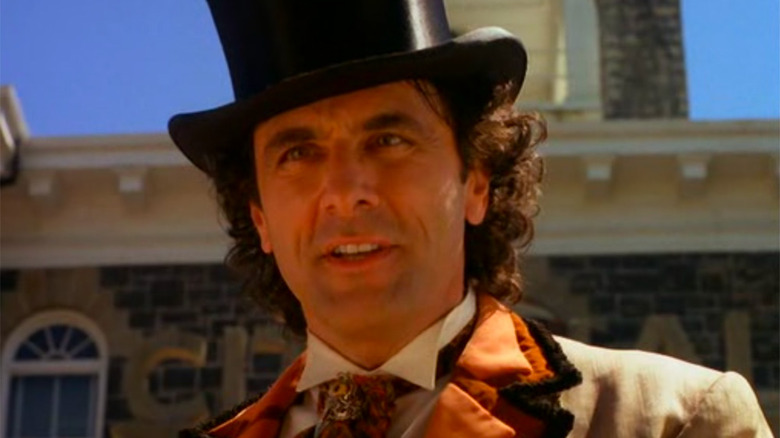Things About Halloweentown You Only Notice As An Adult
In 1998, Halloweentown premiered on the Disney Channel, following the delightfully quirky story of a girl who discovers that her family hails from a village full of vampires, ghosts, and other monsters. Oh, and that her magical potential might be the only thing that can stand up to a sinister force that's up to no good. In the decades since, it's become an October tradition for the kids who grew up with it to rewatch the TV movie, especially the viewers who like their Halloween traditions to be spooky but not scary.
If you're one of those who goes back to Halloweentown every year, then you probably already know that there's a whole lot going on here that you probably didn't notice the first time around. From the surprising names that pop up in the credits to the troubling metaphysical implications of a world where ghosts work out at the local gym, here are the things about Halloweentown you only notice when you're watching it as an adult.
Halloweentown had a serious talent do its music
Kids rarely notice movie credits, let alone recognize specific names of people who aren't even actors. Adults, however, do, and they likely noticed the opening credits of Halloweentown proudly announcing that it has music by Mark Mothersbaugh.
Just in case the name isn't ringing a bell, Mothersbaugh is probably best known as the co-founder and frontman for Devo. In the years since "Whip It" made the band a household name, he's had a pretty prolific career composing film scores. He's worked on pretty much every kind of film that requires a quirky, memorable score, from Thor: Ragnarok to Pitch Perfect 2 to The Lego Movie. However, his work might be most recognizable from his collaborations with director Wes Anderson.
So yeah, it turns out Halloweentown is actually even more awesome than you thought it was when you were a kid. Unless, of course, you were the kind of kid who kept track of what Disney Channel movies were being scored by the guy from Devo, which makes you even weirder than most of this movie's characters.
Marnie clearly doesn't understand the difference between a Wiccan and a witch in Halloweentown
Marnie Piper, the heroine of Halloweentown, is one of the most authentic child characters to ever make it to the small screen, but that is one heck of a double-edged sword. As a kid, you absolutely relate to her when she declares that at 13, she's "practically a grown-up," and, as an adult, you cringe because you remember that feeling all too well.
Marnie's most cringe-worthy moment? After her grandmother arrives with a magical bag of costumes, Marnie gleefully puts on a pointy hat and declares, "I'm a Wiccan!" Considering that Wiccans are members of an actual religion and not just people dressing up in costumes, that may be a little offensive.
But the Halloween-obsessed Marnie has clearly learned that "Wiccan" is a more proper and preferred term for certain people than "witch," and, in her head, that means that's the word she should use when describing one. Not only does this effortlessly show how much she doesn't know about the magical world but it's also exactly the kind of childhood pretentiousness that you don't even recognize you had until you're grown up.
Why is Halloweentown's Marnie so interested in dybbuks?
It's established early on that, despite her mother's best efforts, Marnie loves all things monsters, magic, and Halloween, and this obsession has allowed her to learn a whole lot of relatively obscure stuff. Even so, it's pretty surprising that when she learns about Halloweentown, her very first question is, "Do they have dybbuks and banshees, too?"
Most people are familiar with banshees, the mourning spirits of Irish mythology whose piercing cries herald the death of a loved one, but, if you're not up on your Jewish folklore, dybbukim might be a bit more obscure. The short version is that they're malevolent spirits who possess the living. Considering that grandma Aggie is chatting about Halloween spookums like goblins and vampires, the only thing weirder than Marnie going for deep-cut monsters is Aggie's response that these unholy tormentors exist in her home world of Halloweentown "by the dozens." Yikes.
Here's some food for thought about vampires in Halloweentown
While Halloweentown's population includes some of the more obscure entries of the Monster Manual, it's worth noting that most of the creatures we see are pretty familiar. There's a vampire, for instance, who winds up playing an important role in the plot, if only because her debilitating toothache gives Marnie one of the ingredients she needs for a spell. As a kid, that makes perfect sense. Of course, there are vampires! They're the Halloween monsters!
Grow up a little, though, and you can't help but wonder: What exactly do those vampires eat? We know that there are plenty of misconceptions about monsters, but, if we know anything about vampires, it's that they drink the blood of the living. So, are there just volunteers offering up their jugulars every day at lunchtime? Do the people with the gourds for heads have pumpkin spice blood? Or maybe that's the real reason why there's a bus that travels from Halloweentown to the mortal world on the one night where a vampire wouldn't look suspicious. That way, they can enjoy the buffet before heading back to H-town.
Just how many people are losing their heads in Halloweentown?
At first glance, Halloweentown seems like a whimsical, downright idyllic place full of friendly zombies and wisecracking skeletons. As an adult, however, you can spot a few subtle hints that all is not well. There's a cop who walks by, giving Marnie and Dylan a mean look while swinging around his nightstick, clearly looking to bust some heads, which indicates that there's some kind of crime going on that's being met with violence.
Even more upsetting, though, is when Aggie's friend Harriet mentions that she's been volunteering at the local "headless shelter," baking muffins that its residents can't eat. No heads means no mouths, after all. The whole thing is played for laughs, but, for the grown-up audience, this has some disturbing implications. Being decapitated is apparently such an uncontrolled epidemic here that it requires shelters, where its residents are tended to by cheerful volunteers who laugh at their inability to eat. But hey, no heads means no mouth, so at least you can't hear their endless tortured screams!
The literal specter of racism in Halloweentown
There's a lot of weird stuff going on in Halloweentown, but the movie really shifts its bizarreness into high gear when Marnie and her siblings start gathering up ingredients for their magic spell. That's when we get the inexplicable scene of a ghost who's trying to lose weight, which implies that this departed soul is both physically present and mutable in the same way as living bodies.
The weirdest part, however, is when Sophie grabs a sheet and starts doing what we can assume is an extremely offensive impression of a ghost. The ghost reacts by saying, "Hey, I don't appreciate stereotypes like that, all right," a line delivered with the weariness of someone who's had to deal with this a lot. As a kid, the goofy contrast of Sophie's sheet-ghost and the genuine article is a forgettable gag, but, as an adult, we now have the knowledge that this magical world of delightful goblins and Elvis impersonator broom salesmen also has racism. So that's fun...
Wait, there's an underworld in the Halloweentown universe?
When Marnie and her siblings encounter the ghost trying to lose weight in a sweatbox, the ghost casually drops a line with alarming metaphysical implications: "Hades was nothin' compared to this!" There's a lot to unpack here, but the biggest thing to note is that, in the universe of Halloweentown, there is Hades, a "shadowy place below the earth which was considered the final destination for the souls of the dead," where some "were condemned to eternal torment."
But considering that the ghost mentions the heat, though, it's safe to assume that he's not talking about the silent, eternally unchanging underworld of Greek mythology. Instead, he's likely talking about what most know as Hell and is simply following the weird rules set by the Disney Channel in 1998 by implying the existence of a realm of tortured souls but not actually calling it by its name.
Does the Catholic church have ties to Halloweentown?
The weirdest thing that we see in the montage of Halloweentown's residents is definitely the goblin who is just a straight-up Franciscan friar. As a kid, you probably didn't notice — or, if you did, you probably just assumed that he was on his way to chill with Halloweentown's version of Robin Hood. For adults, however, it raises some truly perplexing questions.
If there's a Franciscan monk in Halloweentown, that means that the Catholic church has at least some sort of presence there, too. So... is there a bishopric of Halloweentown? Does the Pope's authority extend to the pocket dimension of Halloweentown, or does Halloweentown have its own Pope? Does this Halloweentown Pope have a pumpkin head, and, if so, is his miter extra large to fit on top of it or is it normal sized and just perched there hilariously? Furthermore, was St. Christopher, who was often depicted as having a dog head, one of the dog-headed people that we see in Halloweentown? This could mean saints come from Halloweentown...
Is Halloweentown the after-afterlife?
So we know that in Halloweentown, Hell exists, and the Catholic church probably does too. We also know that Halloweentown is populated by ghosts and skeletons who occasionally make references to having once been alive and that at least one of them has been to Hades before moving to Halloweentown.
It's tempting to look at the ghosts and figure that Halloweentown, with its wonky time and placid small-town aesthetic, is something like purgatory with goblins. Put all of those facts together, though, and it's clear that we're dealing with some sort of after-afterlife, where souls can find some measure of peace after suffering through their punishment. But also an immortal Debbie Reynolds is there? We wouldn't be surprised if, with another watch-through of Halloweentown, people had to make serious adjustments to what they thought happens once we die. Honestly, it might be worth it to just consider this movie to be a lost fourth chapter of Dante's Divine Comedy: Inferno, Purgatorio, Paradisio, and Halloweentown.
The truth about Halloweentown's Dark Times
Several times throughout Halloweentown, there's a mention of the "Dark Times" before the founding of Halloweentown. In most movies, a phrase like that would be in reference to something bad happening to the group that's telling the story, and, to younger viewers, it probably seems like a reference to how the humans turned against the monsters, hunting them down and driving them to their own dimension.
As an older person paying a little more attention to the way the story unfolds, though, you get a slightly different picture. These "Dark Times" to which Kalabar is trying to return were when all the ghouls and goblins that are now dentists and postal workers were roaming Earth, terrorizing the population. According to Aggie, life on Earth was "turning [them] evil," driving them to their most violent and terrible extremes. In other words, that "darkness" didn't come from the humans, but rather from the monsters themselves, leading them to talk about it as a shameful and regrettable period of their history. Halloweentown isn't just a movie where the "monsters are people," but where those people can also be monsters, and that's a way more sophisticated take.
Why is Luke unhappy with his looks in Halloweentown?
Part of Kalabar's sinister scheme involves getting Luke, a local goblin, to do his bidding as a minion by giving him the handsome looks of a standard-issue Disney Channel teen. The lesson here is that it's what's on the inside that counts, but, when you're an adult who's seen that moral play out a million times, you might notice that it doesn't really make sense here.
Here's the big issue: What beauty standards is Luke trying to live up to? He's a Halloweentown native, and that place doesn't exactly seem to feature the same ideals of facial symmetry that the movie's mortal world might have. Like, there are people with jack o'lanterns for heads and full-on dog-men running around. Even at his most goblinish, you'd think Luke would at least believe himself to be better looking than the literal rotting corpse selling brooms down the road.
Halloweentown's Aggie needs to stop interfering with her daughter's parenting
Aggie's meddling with Gwen's parenting may be all too familiar to some adult Halloweentown viewers. As a kid watching the Disney Channel movie, you're definitely 100 percent on Aggie and Marnie's side — how could Gwen keep Marnie from reaching her magical potential? — but, as an adult, you're almost certainly way more sympathetic to Gwen.
Part of growing up is learning that you need to get some distance from your parents and to live your own life, and it's really annoying when they keep trying to control your life because they disapprove of your choices. It's even worse if you have kids and they keep undermining your authority, doing things that you've explicitly told them not to do. Gwen's not necessarily right about keeping her daughter from developing her magic powers, but her annoyance with Aggie's meddling and boundary-crossing is definitely understandable.
Dylan is underrated in Halloweentown
Obviously, Marnie is the star of Halloweentown, and she's the focus of Aggie's attention as she tries to lead her to her witchy destiny. Aggie even crafted an elaborate storybook for the sole purpose of having Marnie see herself as a witch. Sophie, the youngest, also gets plenty of screen time devoted to her innate magical talent. Dylan, though? Aggie never even mentions that he might have the potential for magic, even though he's as much a part of the Cromwell line as his sisters. You'd think Aggie would've wanted to win over all of her grandkids, especially since Dylan is also approaching his own 13th Halloween.
It's not like Dylan should be the focus of the film, though. Really, a series of movies about a young boy who learns that he's a wizard and is whisked off to a magical land where he fulfills a prophecy? Who'd want to watch that?
What other worlds exist besides Halloweentown?
During their grand tour of Halloweentown, Aggie explains to her grandchildren that the mortal world's Halloween traditions all have their roots in humans imitating monsters. If you think about that for a moment, you might start to wonder if the same applies to all holidays. Is this a sort of Nightmare Before Christmas situation, where there's a town for each holiday with residents who scoff at the mortals' pale imitations of their traditions?
If that's the case, then we're missing out on a whole expanded Halloweentown universe. Early in the film, Dylan suggests that since Gwen has forbidden her children from celebrating Halloween, she should get into another holiday, and he offers up Arbor Day as a potential replacement. And yet, we got four whole Halloweentown movies and never once got a glimpse of Arbordaytown. Then again, Arbordaytown would probably be just, you know, a forest.
Kalabar was right in Halloweentown
There's no getting around it: Kalabar is a bad guy. He wants to conquer the world with an army of bloodthirsty monsters, he tries to kill Marnie and her family, and he shuts down Halloweentown's only movie theater. Here's the thing, though: He's also kinda right.
Even if Halloweentown residents had once succumbed to their evil impulses in the mortal world, they were still driven out of their home dimension into a separate world where they had to isolate themselves. In the years since, they've certainly chilled out, so why shouldn't they be able to return to the other world? Why shouldn't they be allowed to go home? If Kalabar had actually put the potential move back to the humans' world to a vote as Halloweentown's mayor instead of disguising himself as a shadow demon and trying to murder his constituents, there's a good chance he might've been able to win the whole population over to his side.
